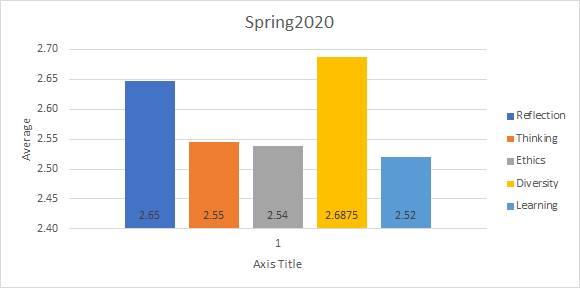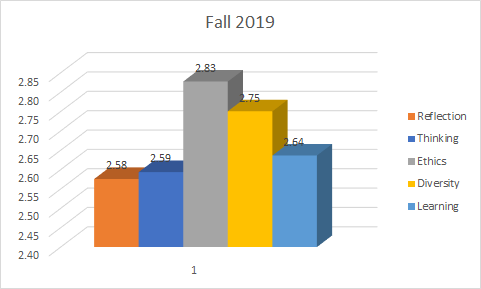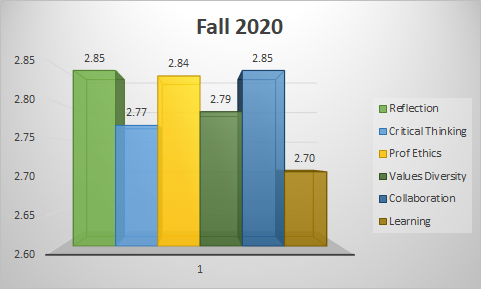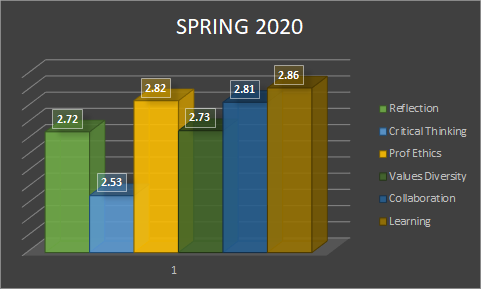AAQEP Accreditation
Standard 1 Aspect F
Standard 1f: Evidence shows that, by the time of program completion, candidates exhibit knowledge, skills, and abilities of professional educators appropriate to their target credential or degree, including: Dispositions and behaviors required for successful professional practice
Data Sources & Analysis
Data Source 1
Counselor Disposition Assessment:
The school counseling program assesses candidate dispositions at two points in the
program: during the practicum and during the internship. The dispositions are the
core values, attitudes, behaviors, and beliefs needed to become an effective and competent
professional. Because student dispositions are an integral aspect of counseling skills
and suitability for field performance, the measurement of dispositions is a natural
component of the school counseling program assessment.
Students are assessed using the department’s 3-point (1 = inadequate 2 = meet expectations 3 =exceeds expectations) likert-type Counselor Dispositional Assessment tool during Practicum (i.e., COUN 208). The likert scale descriptors are listed as evaluation guidelines for each of the dispositions. Included with each disposition are examples of behavioral indicators to help guide the evaluation process. Each indicator is offered as a suggested behavior, and not as a conclusive determining factor. Faculty are able to review data and draw inferences in order to assist with program evaluation methods.
Perspective Captured from Data Source: Practicum Site Supervisor
Rationale for using Data Source:
Measuring student dispositions during the practicum phase is an important aspect of
program assessment and, when combined with systematic progress reviews, constitutes
an essential step for continuous counselor education program improvement.
Specific Elements of Data Source:
The Counselor Disposition Assessment Tool evaluates candidates in six areas:
(a) reflection
(b) critical thinking
(c) professional ethics
(d) valuing diversity
(e) collaboration
(f) life-long learning
Displays of Analyzed Data:
The following graphs show descriptive statistics of items listed on the Counselor
Dispositional Assessment Tool for the following semesters, Fall 2020, Spring 2020,
Fall 2019 and Spring 2018.




Link to Full Dataset:
The reviewer will notice five (5) tabs at the bottom of the excel/Google Sheets document. The last tab titled “items” identifies the specific assessment tool items with the codes for analysis purposes listed below.
Interpretation of Data:
After analyzing the data, the following inferences were made: During Fall 2020, the
average across all items was M=2.55. Students ratings were the lowest (average) on:
- Critical thinking. Examples of behavioral indicators include, but are not limited to: [Utilizes assessment data to adjust counseling approaches, consultation practices, or program implementation.] (x =2.5)
- Professional ethics. Examples of behavioral indicators include, but are not limited to: [Actively advocates for peers and clients, and encourages self-advocacy.] (x =3)
- Valuing diversity. Examples of behavioral indicators include, but are not limited to: [Diagnose clients’ needs by interpreting data from diverse sources (e.g., formal/informal assessments, student/client behavior and feedback, and collateral responses)] (x =2.38)
- Learning. Examples of behavioral indicators include, but are not limited to: [(Field Placement) Collaborates with community partners and agencies in all phases of intervention when possible.] (x = 1.93)
Spring 2020 assessment data yielded a mean score of (M= 2.55). Although the results were not below average, faculty identified mean scores under m= 2.5 to draw inferences. In summary, areas with lower ratings were identified as:
- Reflection. Examples of behavioral indicators include, but are not limited to: [Demonstrates accurate self-analysis regarding one’s own strengths and weaknesses.] (x= 2.65)
- Valuing diversity. Examples of behavioral indicators include, but are not limited to: [Diagnose clients’ needs by interpreting data from diverse sources (e.g., formal/informal assessments, student/client behavior and feedback, and collateral responses)] (x= 2.69)
- Life-long learning. Examples of behavioral indicators include, but are not limited to: [Seeks out opportunities for professional development (e.g., attendance at workshops, in-service training, conferences) using the information learned to improve counseling practice.] (x= 2.52)
Fall 2019 yielded a mean score of (M= 2.83). Although the results were not below average, faculty identified mean scores under m= 2.8 to draw inferences. In summary, areas with lower ratings were identified as:
- Reflection. Examples of behavioral indicators include, but are not limited to: [Demonstrates accurate self-analysis regarding one’s own strengths and weaknesses.] (x= 2.58)
- Valuing diversity. Examples of behavioral indicators include, but are not limited to: [Diagnose clients’ needs by interpreting data from diverse sources (e.g., formal/informal assessments, student/client behavior and feedback, and collateral responses)] (x= 2.62)
- Life-long learning. Examples of behavioral indicators include, but are not limited to: [Seeks out opportunities for professional development (e.g., attendance at workshops, in-service training, conferences) using the information learned to improve counseling practice.] (x= 2.64)
Overall, all students scored in the “meets expectations” range on items unless the skill was “not observed” by supervisors. Information from the assessment activities were brought to program and department faculty for review, group discussions, and program planning. Additionally, the school counseling advisory board was consulted. Based on assessments, the program faculty will focus on increasing students’ scores in the areas of life-long learning and critical thinking. Faculty will revise the curriculum to offer opportunities for candidates to develop their critical thinking skills as well as to develop their life-long learning skills.
The program faculty continue to use formative and summative evaluation measures to improve student outcomes. Furthermore, the Counselor Disposition Assessment is continuously used as a key indicator of student learning during the mid-point of the program (COUN 208) and during the end (COUN 249).
Data Source 2
Counselor Disposition Assessment
Like in the COUN 208 Practicum course, during the COUN 249 Internship course, candidates
are evaluated on their dispositions by their internship site supervisor.
Again, candidates are evaluated using the department’s 3-point (1 = inadequate 2 = meet expectations 3 =exceeds expectations) likert-type Counselor Dispositional Assessment tool. The likert scale descriptors are listed as evaluation guidelines for each of the dispositions. Included with each disposition are examples of behavioral indicators to help guide the evaluation process. Each indicator is offered as a suggested behavior, and not as a conclusive determining factor. Faculty are able to review data and draw inferences in order to assist with program evaluation methods.
Perspective Captured from Data Source: Internship Site Supervisor
Rationale for using Data Source:
Measuring student dispositions during the internship phase is an important aspect
of program assessment and, when combined with systematic progress reviews, constitutes
an essential step for continuous counselor education program improvement.
Specific Elements of Data Source:
The Counselor Disposition Assessment Tool evaluates candidates in six areas:
(a) reflection
(b) critical thinking
(c) professional ethics
(d) valuing diversity
(e) collaboration
(f) life-long learning
Displays of Analyzed Data:
The following graphs show descriptive statistics of items listed on the Counselor
Dispositional Assessment Tool for the following semesters, Fall 2020 and Spring 2020.


Link to Full Dataset:
The reviewer will notice four (4) tabs at the bottom of the excel/Google Sheets document. The last tab titled “details” identifies the specific assessment tool items with the codes for analysis purposes listed below.
Interpretation of Data:
After analyzing the data, the following inferences were made: During Fall 2020, the
average across all items was M=2.79. Students ratings were the lowest (average) on:
- Critical thinking. Examples of behavioral indicators include, but are not limited to: [Utilizes assessment data to adjust counseling approaches, consultation practices, or program implementation.] (x =2.77)
- Professional ethics. Examples of behavioral indicators include, but are not limited to: [Actively advocates for peers and clients, and encourages self-advocacy.] (x =2.84)
- Valuing diversity. Examples of behavioral indicators include, but are not limited to: [Diagnose clients’ needs by interpreting data from diverse sources (e.g., formal/informal assessments, student/client behavior and feedback, and collateral responses)] (x =2.79)
- Collaboration. Examples of behavioral indicators include, but are not limited to: [(Field Placement) Collaborates with community partners and agencies in all phases of intervention when possible.] (x = 2.85)
Spring 2020 assessment data yielded a mean score of (M= 2.79). Although the results were not below average, faculty identified mean scores under m= 2.5 to draw inferences. In summary, areas with lower ratings were identified as:
- Reflection. Examples of behavioral indicators include, but are not limited to: [Demonstrates accurate self-analysis regarding one’s own strengths and weaknesses.] (x= 2.72)
- Valuing diversity. Examples of behavioral indicators include, but are not limited to: [Diagnose clients’ needs by interpreting data from diverse sources (e.g., formal/informal assessments, student/client behavior and feedback, and collateral responses)] (x= 2.73)
- Collaboration. Examples of behavioral indicators include, but are not limited to: [(Field Placement) Collaborates with community partners and agencies in all phases of intervention when possible.] (x= 2.81)
- Life-long learning. Examples of behavioral indicators include, but are not limited to: [Seeks out opportunities for professional development (e.g., attendance at workshops, in-service training, conferences) using the information learned to improve counseling practice.] (x= 2.86)
Overall, all students scored above all different areas across the two semesters. Students scored higher in different areas when compared to the results measured at other points in their training. While the impact of transitioning from face to face to virtual learning due to the Pandemic in Spring 2020 is noticeable in students’ average, candidates still performed above 2.5 across different areas. Even at the end of the training, our program can identify other opportunities to increase our students’ critical thinking abilities that can support their professional development and preparation to work with diverse populations.
The aforementioned items from the Counselor Disposition Assessment are used to evaluate goals as identified in the Student Outcomes Assessment Plan (SOAPs). Based on Goal 1, which is geared towards preparing school counselors to meet the counseling and advising needs of an increasingly diverse and changing student population, faculty continue to assess and modify the program where appropriate. The program faculty continue to use formative and summative evaluation measures to improve student outcomes. Furthermore, the Counselor Disposition Assessment is continuously used as a key indicator of student learning during the mid-point of the program (COUN 208) and during the end (COUN 249).
Data Source 3
Clinical Review
Perspective Captured from Data Source: University Supervisor and Faculty
Rationale for using Data Source:
Counselor educators play an important role as gate-keepers to ensure that only competent
counselors graduate given their critical influence on the lives of the clients they
will serve. Hence, within our School Counseling program, we regard measuring student
dispositions as an important aspect of program assessment. Apart from using the above-mentioned
data sources on candidate dispositions, we also use Clinical Review evaluation to engage in a systematic progress review.
Students are assessed on 10 areas using a 5-point likert-type scale, with 1 being lowest rating and 5 being the highest.
Specific Elements of Data Source:
For this standard, we have analyzed the following 5 areas due to their focus on students’
personal and professional attributes that are critical for their effective professional
practice as school counselors:
(a) attention to ethical and legal concerns,
(b) cooperativeness with others,
(c) awareness of own impact on others,
(d) ability to deal with conflict, and
(e) ability to express feelings effectively and appropriately
Displays of Analyzed Data:
| - | Total Number of Students |
A Average Score |
B Average Score |
C Average Score |
D Average Score |
I Average Score |
|---|---|---|---|---|---|---|
| Fall 2019 | 7 | 5 | 4.71 | 5 | 4.86 | 4.71 |
| Fall 2020 | 21 | 4.86 | 4.86 | 4.86 | 4.86 | 4.86 |
| Spring 2021 | 14 | 4.79 | 4.79 | 4.71 | 4.71 | 4.29 |
Link to Full Dataset:
Interpretation of Data:
As evident from the complete dataset, so far, all school counseling students have
passed clinical review and have been rated highly in the 10 dimensions of candidate
dispositions listed in clinical review survey: (a) attention to ethical and legal
concerns, (b) cooperativeness of others, (c) awareness of own impact on others, (d)
ability to deal with conflict, (e) openness to new ideas, (f) tolerates ambiguity,
(g) willingness to accept and use feedback, (h) ability to accept personal responsibility,
(i) ability to express feelings effectively and appropriately, and (j) initiative
and motivation. We will continue to evaluate students’ personal and professional dispositions
periodically and support their continued growth as counselors in training.
Next Steps:
Based on the three data sources included in this documentation, we can conclude that
school counseling program faculty and students have demonstrated a strong understanding
about the importance of evaluating students’ personal and professional dispositions
as counselors-in-training. Through responding to the candidate dispositions survey,
site supervisors during the practicum and internship courses evaluated students in
the following six areas: (a) reflection, (b) critical thinking, (c) professional ethics,
(d) valuing diversity, (e) collaboration, and (f) life-long learning. Further, through
responding to the clinical review survey, university faculty and supervisors evaluated
students in the following ten areas: (a) attention to ethical and legal concerns,
(b) cooperativeness of others, (c) awareness of own impact on others, (d) ability
to deal with conflict, (e) openness to new ideas, (f) tolerates ambiguity, (g) willingness
to accept and use feedback, (h) ability to accept personal responsibility, (i) ability
to express feelings effectively and appropriately, and (j) initiative and motivation.
As evident from the data, students have mostly received high ratings on each of these
dimensions. However, three items for which students received lower ratings across
semesters were valuing diversity, collaboration, and lifelong learning. These items
focused on students’ capacity for self-advocacy, developing interventions for diverse
groups of students, collaborating with other school personnel, and pursuing professional
development opportunities beyond the opportunities provided at university-level (e.g.,
joining professional organizations). It is unclear however, if students did not receive
these opportunities to collaborate, develop intervention plans for diverse groups
of K-12 students and pursue beyond-classroom professional activities or were they
not willing or ready to do so. In future, we will discuss these findings in department
meetings and revise the course syllabi to ensure that students are provided opportunities
to develop these professional dispositions.
Moving forward, we will consult with site supervisors and advisory board members on improving individual mentoring and advising, documenting student progress, making changes in the curriculum, and communicating with faculty on the dispositions that we need to further focus on.
We will further continue to use formative and summative evaluation measures to improve student outcomes on candidate dispositions and clinical review surveys especially during the practicum and internship courses. Based on future accreditation efforts (e.g., AAQEP, CCTC, CACREP), we will also continuously update the disposition assessments as key indicators of students’ personal and professional growth as school counselors.